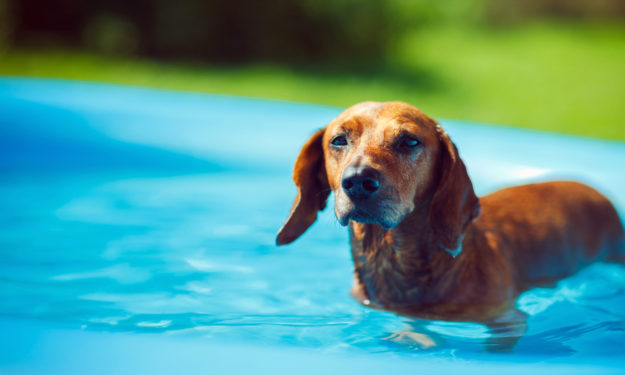Pool Safety for Dogs (And Cats Too!)

It has certainly been a long hot summer! During these blistering humid days, a backyard pool is a perfect source of fun and cooling off for the whole family – including your pet! Whether you have a retriever who loves to jump in after a toy or an outdoor cat who sneaks in a few sips when no one’s looking, there are pool dangers and safety precautions every pet owner should be aware of. Many of us wonder:
Is pool water safe for my dog or cat?
Is it okay to let them go swimming?
How can I keep my pet safe around my pool?
What is in pool water?
Most pet owners are concerned about the effects that chlorine may have on their pet. The chlorine in your pool breaks down into hypochlorous acid and hypochlorite ion, both of which kill microorganisms and bacteria lurking in the water.
The dangers associated with chlorine are, like most things, dependent on the dose or amount of exposure. Anything, including water with no additives, can be toxic if ingested in excess. Pools actually contain very dilute concentrations of chlorine, and thus do not pose significant harm in that regard. While you should discourage your dog from swallowing large amounts of chlorine water, a GI upset is generally the worst side effect.
Pets may also develop red eyes or itchy skin depending on how sensitive they are and how long they stay in the water. Frequent doggy swimmers may develop ear infections too; speak with your veterinarian for recommendations regarding an ear cleansing/drying solution which will help to remove excess water from the ear canals. We also recommend hosing down or bathing your dog after swimming to remove the chlorine from their fur and skin and avoid irritation or excessive licking.
Are there alternatives to chlorine?
If you are still worried about the dangers of chlorine use, you may consider purchasing an alternative, such as bromine. While more expensive, there are less reported instances of irritated eyes and skin. However, it becomes less stable when exposed to sunlight and thus may not be the best choice for an outdoor pool.
Another alternative is buying a plastic kiddie or wading pool to use outside which you can fill with the hose. This allows them to safely keep cool and many dogs actually prefer laying in the warm, shallow water over swimming!
What other dangers are there?
- The first swim: Many dogs become fearful when in the water for the first time, especially upon trying to exit. Take it slow, support them if they need it, and show them where the steps are to get out. Never force or throw your dog into the pool. We recommend using a canine life vest until they are comfortable swimming on their own.
- Supervision: Supervision is most important. It is vital that you never leave your pet unsupervised in the pool, as they may be unable to bark to signal their distress. If your pet does fall in, don’t assume that they will find their way out. They will likely be distressed and panicked and may not be able to find the exit or pull themselves out.
- Pool toys: Never leave toys or floats in the pools when you’re not around. These may entice your pet to jump or fall in when unsupervised.
- Access to water: Always have fresh water available nearby so your pet won’t start drinking the pool water to quench their thirst.
- Keeping them away: If your pool isn’t fenced in or blocked off, consider buying a cover or net to keep your pets safely away when you let them out in the yard.
All in all, pools can be a safe and fun activity for you and your pets as long as you’re careful. Just like kids, dogs & cats must be supervised at all times and follow typical pool precautions. And of course, have fun!